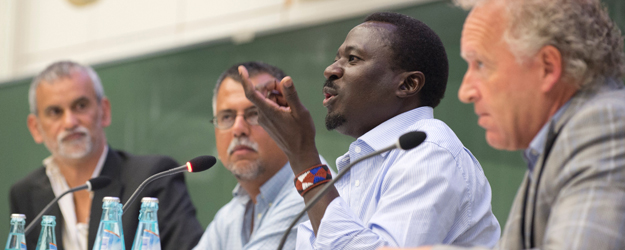5 June 2012
African museums are no longer just repositories for dusty exhibits. Instead, they have become melting pots for society, where people discuss politics, continue their education, or play sports. Three experts discussed this development at the invitation of Gutenberg Endowed Professor Friedemann Schrenk.
"What are you digging out there?", asked some of the locals in Karonga, Malawi. "We want to see it." – "So we decided it to show it to them", says Friedemann Schrenk.
As holder of the Johannes Gutenberg Endowed Professorship 2012, the renowned German paleoanthropologist came to Mainz University to retrace the footsteps of modern man in his lecture series "Out of Africa: Towards a global history of Homo sapiens." Right at the beginning of the lecture series, however, he had also promised that contemporary Africa would also play a major role in the program. And Schrenk honored this promise by inviting three guest to speak about a special kind of museum on the African continent in a lecture entitled "Transfer and reception – The role of museums in und for Africa."
Educational objective: cultural development
"I am not very familiar with things like this," Schrenk said modestly. "I specialize in dead people, not the living ones." In fact, the Culture and Museum Center Karonga came into being because of Schrenk’s decision to show people the hominid fossils he excavates in their region. "When we talk about development assistance, it's not just about food or healthcare. It's also about cultural development. We still have to learn that," Schrenk told the audience at RW1, the largest lecture hall at Johannes Gutenberg University Mainz.
"There isn't just one definite role for culture in the world. Culture can be used to divide people or can even be misused to commit acts of genocide. But it can also create a community," claims Mike van Graan. Among other things, van Graan advised the cultural minister in Nelson Mandela's first cabinet, occupies leading positions in organizations that promote African artists, and is considered to be one of the most important playwrights in contemporary South Africa.
Legacy of colonial rulers
Van Graan has seen how museums, as a legacy of the colonial rulers, were also used as instruments of apartheid. However, he has also experienced how these institutions have dramatically changed their image in Africa. One example of this is Fort Jesus.
Dr. George Abungu, archaeologist and Vice President of the International Council of Museums in Kenya, said, "Museums have a history. For us, too, they were important cultural institutions in which the identity of a nation found expression and where the greatest exhibits were maintained." This very notion the Africans had taken over from the colonial rulers.
From prison to museum
"But, in the 1990s, people started asking if museums could play a more active role in our society?" This is where Fort Jesus in Mombasa came into focus. Built in 1593 by the Portuguese, the complex is considered to be a masterpiece of fortification for its time. Under later rulers, including the British, it became a prison – and then finally a museum.
"We asked all the communities what their vision of the place was," tells Abungu about the rededication of the fortress. Various population groups expressed their opinions. "Fort Jesus became a melting pot, a place where we said goodbye to the past and looked towards the future." The former exhibition site served as a training center for young people. They learned how to renovate their homes. It was a place for discussing politics and culture. "The museum even left its walls and moved outside," says Abungu. People now play soccer in the museum's shadows. "Sometimes the ball hits the walls, but that's not a problem." Fort Jesus, declared a World Heritage Site in 2011, has matured into an institution that is concerned with peoples' economic interests, the environment, and even sports.
Museums are changing across Africa
Ciraj Rassool, director of the African Program in Museum and Heritage Studies at the University of the Western Cape, tells of a similar museum: the District Six Museum in Cape Town has also become a place for meeting, education, and discussion. Van Graan, for example, has given workshops here on the history of theater. "We are living in a time, in which the concept of the museum, as we know it, is fundamentally changing," says Rassool. "Throughout Africa."
But there is yet another aspect that is close to his heart. The colonial powers plundered Africa in many ways, with fossils, art, and religious artifacts finding their way into collections around the world. But it didn't stop there: In 1909, the Austrian ethnographer Rudolf Pöch unearthed corpses and sent their bones to his Viennese Museum Collection. At that time, the San Bushmen were considered to be representatives of an early form of mankind. This had to be documented, Pöch believed, without any consideration for ethical niceties. The mortal remains of Klaas and Trooi Pienaar from the Khoisan ethnic groups were thus shipped to Vienna.
Klaas and Trooi Pienaar return home
Rassool describes how people's attitudes to such activities gradually changed. The objects began to be returned to Africa. Corresponding laws led to negotiations with museums all over the world. A process of rehumanization was necessary, too. It was time for Pöch's exhibits to be returned home.
"Someone once joked in the Vienna Museum, 'You want to meet Trooi and Klaas? Here they are.' And they handed over a few bones." The atmosphere during the negotiations was tense. It took time for each party to understand the other's position. However, in April 2012, Trooi and Klaas Peinaar's remains were finally returned to South Africa.
"Mutual understanding and respect, that is what is important to us," Abungu comments. This is also the sort of approach that African museums have taken. "In the past, like all other museums, ours had dusty exhibits. Today, we are responding to the needs of the people."




